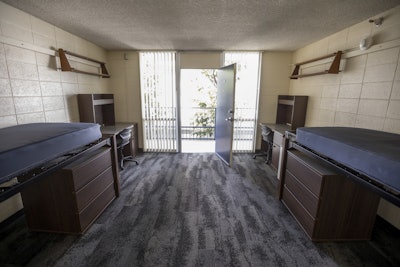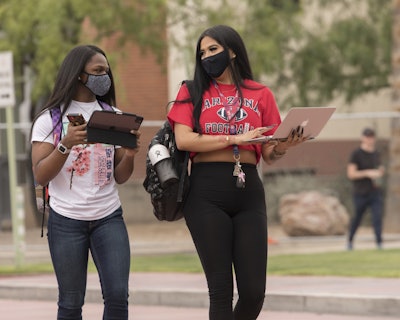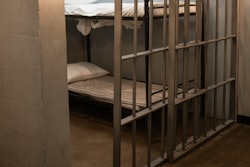At the end of June, 97% of college presidents reported that their universities planned to offer a mix of online and in-person learning in response to the coronavirus this fall, according to a survey by the American Council on Education.
But now, schools are increasingly reversing course, returning to online classes in response to the ongoing pandemic.
“What we’ve seen is that many schools that planned to re-open for at least some in-person instruction decided that they could not do so safely,” says Dr. Terry Hartle, senior vice president of government relations and public affairs at the American Council on Education. “But it’s always been the case that the course of the pandemic would determine the ability to open and the ability to stay open.”

“After consultation with our public health faculty experts, District of Columbia officials, University leadership, and monitoring the status of the COVID-19 pandemic locally, regionally and nationally, we have made the very difficult decision to move all undergraduate courses for the Fall 2020 semester fully online, and non-residential,” said Dr. Wayne A. I. Frederick, Howard’s president, in a statement to the campus community.
Other institutions, however, welcomed students back to campus, quickly resulting in upticks in COVID-19 cases. At least 19 states had coronavirus outbreaks on college campuses by the end of August.
The University of Alabama, Duke University and North Carolina State University, among others, all saw swiftly rising cases after reopening. Notably, Notre Dame racked up 448 coronavirus cases in 20 days. The University of North Carolina at Chapel Hill found at least 10 clusters of COVID-19 among students, spurring a fiery op-ed in The Daily Tarheel, the university’s student newspaper.
“We’re angry — and we’re scared,” the editorial board wrote. “We’re tired of the gaslighting, tired of the secrecy, tired of being treated like cash cows by a University with such blatant disregard for our lives. UNC is often recognized for the ambition demonstrated by its students and faculty, and the administration’s insistence to maintain an on-campus presence amid a pandemic can definitely fall under that. One thing’s for sure — this roadmap leads straight to hell.”
Ultimately, university leadership decided to reclose campus in favor of online classes.
“As much as we believe we have worked diligently to help create a healthy and safe campus living and learning environment, the current data presents an untenable situation,” wrote Dr. Kevin M. Guskiewicz, UNC-Chapel Hill’s chancellor, and Dr. Robert A. Blouin, UNC-Chapel Hill’s executive vice chancellor and provost, in a letter to the community. “As we have always said, the health and safety of our campus community are paramount, and we will continue to modify and adapt our plan when necessary.”
Towson University, North Carolina State and others followed in closing as their coronavirus cases rose.
“This is hard, this is unprecedented and colleges and universities like every other organization in the country are doing the best they can,” Hartle says.
Reopening precautions
Against this backdrop, many universities are still forging ahead with hybrid learning plans, like the University of Arizona, where about 5,000 students returned on Aug. 24, after showing negative coronavirus test results. Faculty and staff were tested as well.
The school built and installed 1,329 sneeze guards, designated a quarantine building with about 400 beds and distributed 5,000 spray bottles
“The app is a vital part of our plan to mitigate the risk of COVID-19 as we return to campus over the coming weeks with our on-ramp approach,” said Dr. Robert C. Robbins, the University of Arizona’s president. “I am very proud of our partnership with Covid Watch, which allows us to prioritize privacy while using this incredible technology for exposure alerts. I hope our entire campus community takes advantage of this resource. The more people who use it, the safer we will be.”
In terms of classes, the campus is taking an “on-ramp” approach to in-person learning, Robbins explained in a briefing. The students back on campus will start with online courses for several weeks, with only specific classes in person, particularly those that require a research lab or arts studio. Other students will continue their courses online at home. Unless cases rise or local hospitals fill, the university will proceed with a second phase, bringing more people back to campus for small-scale classes, up to 30 people.
The president will receive regional data — like cases in the region and how prepared local hospitals are to take care of sick campus community members — and university-wide metrics — like the results of students’ coronavirus testing — every day, in addition to nation and statewide statistics on coronavirus cases, says Dr. Richard Carmona, a distinguished professor of public health, health promotion sciences & community, environment and policy.
A former U.S. surgeon general, Carmona is spearheading the university’s COVID-19 safety protocols, using an Incident Command System model (ICS), a hierarchy used by public agencies to make decisions efficiently in an emergency.
The decision to try a phased re-opening plan came after demand from students and parents.
“After much discussion, if we can decrease the risk, if we can have good public health programs, we thought it was worth the effort …” Carmona says. “The first step was, can we do this relatively safely if the students agree to comply? And the answer was yes, maybe.”
The “maybe” is about whether students will follow Centers for Disease Control and Prevention guidelines. Carmona is in contact with other universities and well aware of how hard it can be to get students on board with social distancing. It’s the part of the plan that he knows is out of his control, though the school has signage encouraging appropriate distance and student ambassadors to remind students of safety protocols.
Every public health issue comes down to one question, he says. “How do you effect sustainable behavioral change in a population? … No more bro hugs, no more high fives, or partying with your friends off-campus. I can tell you, it’s the thing that keeps us up at night: can we effect sustainable behavioral change.”
He’s hopeful — but remains cautious.
“We will continue to move forward as long as the metrics are indicating that we’re still safe,” he says.
Hard choices
These decisions about campus reopening — to put it mildly — haven’t been easy.
With little federal guidance or oversight, “there’s simply no road map for this,” Hartle says. “They don’t teach you how to cope with a pandemic in college president school.”

For example, “presidents a couple months ago were all looking for tests that were cheap, fast and reliable and those don’t really exist,” he says.
And the “biggest unknown” is how students will behave, given the country at large isn’t uniformly following social distance protocols.
Ultimately, he says there’s no one-size-fits-all option. Campuses are asking the same fundamental questions: “How do we clean? How do we test? How do we trace? How do we isolate? How do we social distance?” But “it’s a different experience on every campus,” he added.
That’s in part because coronavirus infection rates differ so widely depending on where a college is located. The “biggest factor” for leaders in making choices about re-opening is whether local COVID-19 cases are increasing or decreasing in their area, numbers that can be in flux.
Plus, concerns about reopening vary by institution, Hartle noted. Residential colleges face a host of decisions about safety protocols in the dorms, while community colleges largely don’t. But they have their own struggles as commuter schools, with more students coming and going from campus. Meanwhile, some universities have the resources to offer widespread testing, while others do not.
Ultimately, colleges and universities are also businesses, Hartle says, “and all businesses are facing a very uncertain and ambiguous situation because of the pandemic.”
Students are calling for tuition reductions in the face of another semester of online learning, but institutions fear state budget cuts and reduced enrollment. Financially, the best option for colleges is to fully open, which is “simply not possible in the fall of 2020.”
The key is to be “nimble,” Hartle says. “They have to be resilient, change directions as the circumstances change. It’s a real-time test of how to govern in a period of great uncertainty. The plans you make this week may not be viable ten days from now.”
This article originally appeared in the September 17, 2020 edition of Diverse. You can find it here.



















